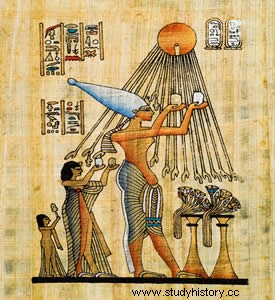(Cescem-SP) The historical importance of Amenotep IV (Amenhotep), Egyptian pharaoh during the so-called New Kingdom (1580 BC – 1110 BC), lies in the fact that he has:
- promoted a religious revolution by establishing a monotheistic cult.
- resisted the military invasion of a major Hyksos-led Asian alliance.
- sponsored the construction of the greatest funerary monuments in Giza.
- expanded the Memphite political domain to the territories of Libya and Ethiopia.
- carried out a social revolution that eliminated the slavery of the farmers.
The so-called New Kingdom (1539-525 BC) of Egypt was the last period of the political division of the Egyptian Civilization. The New Kingdom began after a reunification of the Egyptians who were, at the time, under the rule of:
- Assyrians.
- Hebrews.
- Hyksos.
- Phoenicians.
- Persians.
Regarding the period in the history of the Egyptian Civilization, known as the New Kingdom (1539-525 BC), analyze the statements below.
I – The Empire's control over a large portion of land also fostered the formation of more intense commercial activities, which included the importation of wood from Phoenicia, of precious metals from Nubia and resin from Greece and other regions of the Eastern world;
II – It was during the New Kingdom that the Hebrews had settled in Egypt, approximately in the thirteenth century BC. Hyksos, the Egyptian government converted the Hebrew population to the condition of slaves;
III – The change brought about by Amenhotep IV did not last within Egyptian society. Tutankhamun, son of Amenhotep, as soon as he came to power, tried to restore the old monotheistic religious traditions with the recovery of the temples that had been abandoned.
About the above statements, mark the alternative:
- If I and II are correct.
- If I and III are correct.
- If II and III are correct.
- If all were correct.
- If all were incorrect.
Review the information contained in the columns below, where there are indications of some Egyptian pharaohs and some of their actions.
| I - Thutmose III (1480-1448 BC) | a - Defeated the Hittites in the Battle of Kadesh. |
| II - Ramses II (1292-1225 BC) | b - He died young, at the age of 19, and his tomb was discovered almost intact in 1922. |
| III - Tutankhamun (1358-1352 BC) | c - Established monotheism as an official religion. |
| IV - Amunhotep IV (1377-1358 BC) | d - It took the Empire to its greatest territorial extension. |
Mark the alternative that correctly indicates the correlation between the two columns.
- I-c; II-d; III-b; IV-a.
- I-d; II-a; III-b; IV-c.
- I-b; II-c; III-c; IV-b.
- I-a; II-d; III-c; IV-b.
Look at the image below:

In the image it is possible to perceive the representation of an Egyptian cult to a god whose symbol is a solar disk. The worship of this god represented a religious revolution driven by a pharaoh of the New Kingdom to the growing power held by the Egyptian priests. What was this pharaoh and what was his revolutionary action?
- Pharaoh Tutankhamun and the transformation of the pyramids into temples.
- Pharaoh Amenemhat III and the Creation of Polytheism.
- Pharaoh Amosis I and the end of the practice of anthropozoomorphism.
- Pharaoh Amunhotep IV and the end of polytheism.
- Pharaoh Thutmose III and the adoption of monotheism.
Letter A . The main mark of Amenontep IV was to establish monotheism as a way of trying to reduce the political power of the priests.
question 2Letter C . The Hyksos dominated the Egyptian Empire at the end of the Middle Kingdom, after warlike actions that included the use of horses, war chariots and weapons made of iron, instruments not known to the Egyptians.
question 3Letter A. The Affirmative III is incorrect because Tutankhamun re-established monotheistic, not polytheistic, religious traditions.
question 4Letter B.
question 5Letter D . To combat the growing power of the priests, Amenhotep IV put an end to polytheism and made the god Aten, represented by the sun disk, the only official god, going on to adopt monotheism for a small period of Egyptian history.
